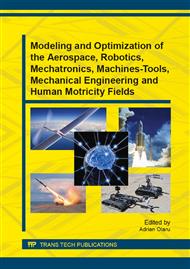p.3
p.11
p.18
p.26
p.32
p.40
p.49
p.57
p.66
Modelling and Simulation of Suborbital Launcher for Testing
Abstract:
The purpose of this paper is to present some aspects regarding the computational model and technical solutions for multistage suborbital launcher for testing (SLT) used to test spatial equipment and scientific measurements. The computational model consists in numerical simulation of SLT evolution for different start conditions. The launcher model presented will be with six degrees of freedom (6DOF) and variable mass. The results analysed will be the flight parameters and ballistic performances. The discussions area will focus around the technical possibility to realize a small multi-stage launcher, by recycling military rocket motors. From technical point of view, the paper is focused on national project “Suborbital Launcher for Testing” (SLT), which is based on hybrid propulsion and control systems, obtained through an original design. Therefore, while classical suborbital sounding rockets are unguided and they use as propulsion solid fuel motor having an uncontrolled ballistic flight, SLT project is introducing a different approach, by proposing the creation of a guided suborbital launcher, which is basically a satellite launcher at a smaller scale, containing its main subsystems. This is why the project itself can be considered an intermediary step in the development of a wider range of launching systems based on hybrid propulsion technology, which may have a major impact in the future European launchers programs. SLT project, as it is shown in the title, has two major objectives: first, a short term objective, which consists in obtaining a suborbital launching system which will be able to go into service in a predictable period of time, and a long term objective that consists in the development and testing of some unconventional sub-systems which will be integrated later in the satellite launcher as a part of the European space program. This is why the technical content of the project must be carried out beyond the range of the existing suborbital vehicle programs towards the current technological necessities in the space field, especially the European one.
Info:
Periodical:
Pages:
32-39
Citation:
Online since:
June 2014
Authors:
Keywords:
Price:
Сopyright:
© 2014 Trans Tech Publications Ltd. All Rights Reserved
Share:
Citation:


